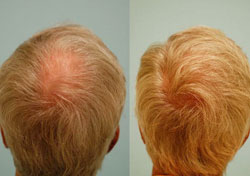In a hair restoration procedure, aesthetics plays a significant role. Hair transplant surgeons can be likened to sculptors who must put a lot of efforts on aesthetic in order to create a good outcome after their job is done. The correct hairline placement, hair density, and distribution should be carefully considered in order to generate a more natural appearance after the hair restoration procedure is completed.

Understanding the Importance of Transplanted Hair Growth Direction
It is always important to give significant considerations on the angle or pattern of the recipient areas on the scalp. This will identify the absolute direction of hair growth and this is why extracted hair must be carefully situated into the placement where it originally grew. Generally, frontal hair towards the vertex transition must be transplanted in a way that it will point forward, making a more acute angle as it approaches the frontal hairline. Regardless of the forehead’s slope, the emergent hair should be pointing horizontally towards the ground at the anterior hairline. In effect, the hair at the anterior hairline will continue to grow forward until it reaches the temples wherein abrupt changes would occur later on. The direction of hair growth would suddenly become a downward anterior, while hair at the top of the temples would grow downward posterior.
Creating a Natural Look
Perhaps the most common thing that patients worry about would be the final result, specifically, on whether it will look natural or artificial. Of course, both surgeons and patients always wish for the best results after the said surgeries. Outcome is often undetectable in most surgical cases but in order to eliminate anxieties, a new procedure can be employed. This new procedure is somewhat similar to the traditional procedure however, it does not require shaving on donor areas. It simply means that donor hair does not need to be shaved short, leaving and transplanting the same hair length on the recipient zone. Hence, it is likewise known as the Long Hair Transplant technique.
Real Time Results
Certainly, the said technique is more complex compared to the traditional procedure. Since hair grafts are left the same way, the long hair transplant method is believed to be more labor-intensive when it comes to strips extraction, donor area preparation, actual grafting, recipient site incisions, as well as the actual transplant of individual grafts. Nonetheless, patients can assess developments in real time since they can actually see results while the procedure is being done.
Accurate Density and Coverage
Ideally, the success rate of traditional hair transplants is evaluated after 4 to 6 months of surgery, when hair starts to grow. But when you opt for long hair transplant, you have the benefits of being able to see the results instantly, so you don’t have to wait a long time to see the results. Such technique also allows surgeons to visualize preoperative plans. In fact, both surgeons and patients can freely interact, working hand-in-hand to achieve the desired outcome. With a long hair transplant, surgeons are fully aware of the patient’s preference on the density, coverage, or concentration of hair.
